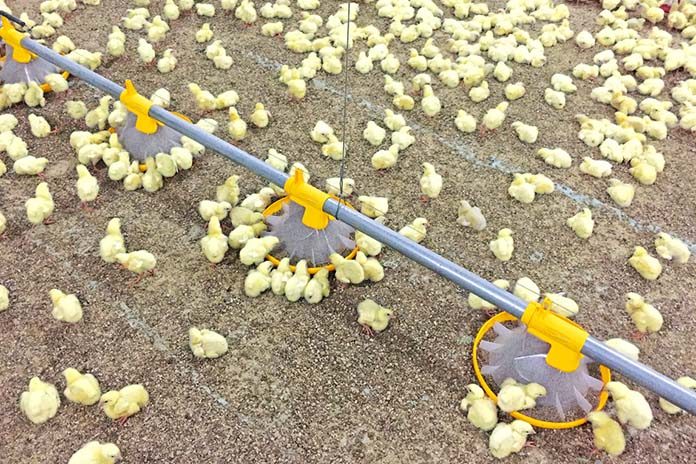
Some recent research at the Arkansas Agriculture Experiment Station Poultry Research Farm has been focused on low protein diets in broilers. Many nutritionists rely on the ideal protein concept with constant evaluation of amino acid needs in modern broiler strains, amino acid content of feed ingredients, and their respective digestibility values. However, feed grade sources of valine have now entered formulation in some locations, which has led to a global discussion of the need of the amino acids beyond valine and the CP point of diminishing return in practical diets.
Data presented herein from research at the Arkansas Agriculture Experiment Station, the University of New England, and elsewhere indicate large variations in CP (four percentage points) in growing broilers may be too extreme, or the work failed to satisfy a critical amino acid or nitrogen need. But marginal reductions in CP, while paying more attention to the so-called “conditional essential amino acids”, such as glycine and serine, as well as relaxing less limiting amino acid needs (i.e., arginine, valine, and isoleucine), warrants more attention due to tremendous cost savings. Clearly, reducing amino acid needs from intact protein sources improves the environment. The addition of each feed grade amino acid in poultry diets necessitates knowledge of its estimated need “requirement”, as well as adequate knowledge of the need of the next limiting amino acid. Hence, the first limiting amino acid, that constitutes its least cost minimum from intact protein sources, sets dietary CP in linear programming.
Four essential and primary limiting feed grade amino acids (i.e., synthetic methionine, and crystalline lysine, threonine, and valine) have been included in poultry diets in commercial settings. In addition, feed grade crystalline and synthetic tryptophan was included in poultry diets in the 1990’s. Availability of these feed grade amino acids has enabled the poultry industry to produce diets that are nutritionally balanced and economically viable. However, the need to reduce nitrogen excretion into the environment and to spare matrix space for the inclusion of less energy dense ingredients in feed formulation begs for a systematic look of CP level of poultry diets. Experimentally, a clear framework for all feed grade amino acids to be included in a semi-synthetic low protein diet that supports good live performance has not been established..
Low CP/AA needs
Research with methionine and lysine, but not threonine, has been shown to vary in terms of amino acid responses as a function of amino acid level and broiler strain. Work by Almquist demonstrated that the arginine requirement of chicks could differ over 100% as a function of strain. In the past it seemed that faster growing broilers required more amino acids whereas now it seems that strains with increased whole body protein from breast deposition to fat ratio are more responsive to amino acids.
The broiler strain utilized in Authors’ laboratory has been limited to the fast feathering Cobb 500 broiler. A titration of CP from 16.0 to 20.0% of diet in increments of 0.8% CP was conducted to pinpoint the sensitivity of less limiting or nonessential amino acids in diets fed to Cobb500 male broilers. Diets were formulated to be equal in total sulfur amino acids, lysine, threonine, valine, isoleucine, arginine, and tryptophan. Whereas less limiting essential and non-essential amino acids were allowed to fall to the designated CP level. Quadratic responses occurred for breast tenders (Pectoralis minors) and total breast yield relative to live BW with maximal responses approximating 19% CP. As CP increased, however, a linear reduction in thigh yields was observed (data not presented). Trends for BW gain were not significant, but feed conversion improved linearly with progressive CP increases. Similarly, protein efficiency ratio was improved linearly as CP was increased. In a companion study, utilizing the same diets (20 vs 16% CP), a mixture of glutamine, glycine, and leucine (++AA) was added to the 16% CP diet, in addition to total sulfur amino acids, lysine, threonine, valine, isoleucine, arginine, and tryptophan (+AA). The addition of essential amino acids and the addition of leucine and the non-essential amino acids failed to support live performance equal to the control or processing attributes.An amino acid density study was conducted using two diets: a diet balanced in all essential amino acids and a diet balanced in the most limiting essential amino acids with 5% reductions in valine, isoleucine, and arginine. The diets were fed to sex separate Cobb 500 broilers from 1 to 28, 1 to 35, and 1 to 42 d of age. Diet did not impact BW gain in any period. However, feed conversion was impaired with unbalanced diets in the 1 to 35 d period, but not the 1 to 28 or 1 to 42 d periods. Unbalanced diets had more abdominal fat in 42-day old females, but not males, indicating their sensitivity of fat over lean accretion as they age. Males had more woody breast with respect than females, but low protein diet effects on woody breast did not occur.
Ospina-Rojas et al. fed low protein diets (3%) to Cobb 500 broilers from 1 to 21 and 22 to 24 d of age. The low protein diets were adequate in methionine, lysine, and threonine as achieved by feed grade amino acids and intact protein, and individual or combined treatments of valine, isoleucine, arginine, and glycine were implemented. To sustain good performance and reduce N excretion, both valine and glycine were needed in the starter period, but valine, isoleucine, arginine, and glycine were needed in the growing period. Indeed, recent studies demonstrated breed standard performance for the starter period in birds fed diets 20.9% CP. The diets were adequate in most of the essential amino acids (i.e., total sulfur amino acids, lysine, threonine, valine, isoleucine, arginine, and tryptophan), as well as glycine.
From the Proceedings of the Australian Poultry Science Symposium

















